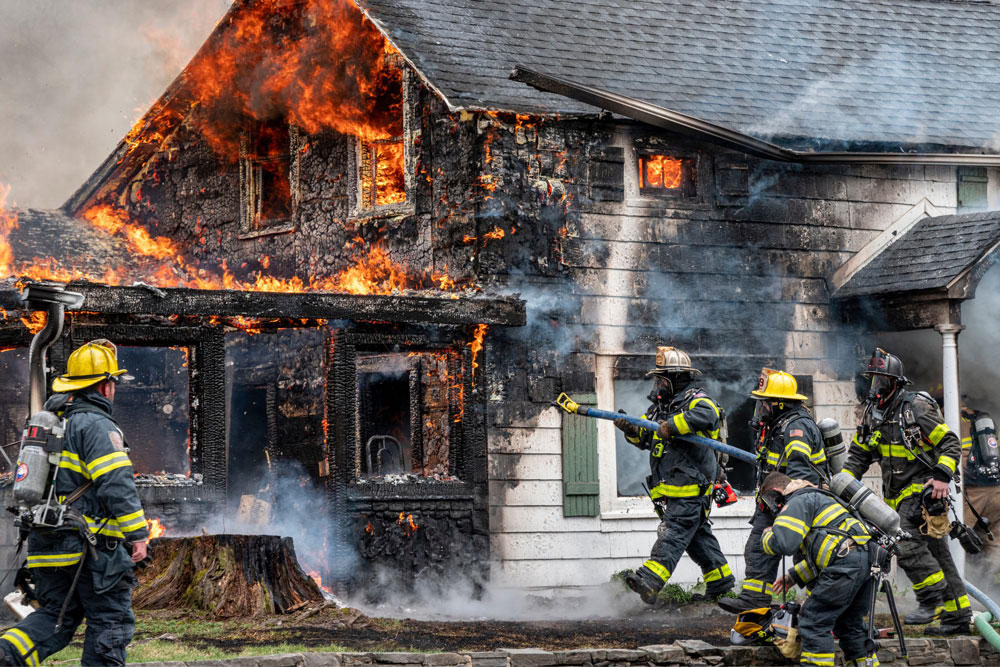How To Clean Up After A Fire
 CONTENTS
CONTENTS
- Inspect and assess the fire damage
- Dispose of waste
- Remove water from extinguishing methods
- Clean up the fire damage
- Restore the property
- What you should do after a fire
- Get in touch
Dealing with the aftermath of a fire on your property can be a challenging, upsetting experience that is best left to the professionals. After fire clean up requires a blend of expertise and specialist equipment, as well as immediate and efficient action to restore the property back to a safe, habitable condition.
Here at ICE Cleaning, we offer our comprehensive fire damage cleaning services nationwide. Our fire restoration specialists can remove soot and ash, collect waste, and neutralise lingering smoke odours. In an emergency, they can be on site within several hours.
Keep reading to find out more about how to clean up after a house fire.
Inspect and assess the fire damage
Fires not only wreak visible havoc but also compromise building integrity and damage electrical wiring. The full scope of the damage must be assessed before you enter the property.
A professional will thoroughly survey the damage including testing materials for stability before starting repairs to prevent potential accidents during clean up or restoration.
Armed with specialised equipment and expertise, they are skilled at uncovering not only the evident destruction but also lurking hazards that are not immediately visible. This includes water damage within walls or harmful substances like soot in the air.
Experts also know how to document damage comprehensively, helping you get fair compensation from your insurer. You can find out more about who should clean up after a house fire in this blog.
Dispose of waste
Following a blaze, the remnants include a myriad of debris, some of which are perilous substances that can put people at risk of health problems. Fire clean up experts have the necessary training and equipment to safely handle and dispose of such materials. They will follow strict regulations to ensure the waste is disposed of legally and sustainably, and does not endanger people's health or the environment.
Beyond safety concerns, there is also the matter of efficiency and effectiveness. Professional teams use specialised techniques and tools designed specifically for post-fire clean ups. Employing these professionals guarantees that every bit of debris is meticulously cleared from your premises, facilitating a swift return to normalcy.
Remove water from extinguishing methods
Dealing with the aftermath of a fire includes tackling the water used to put it out. The process of removing water after a fire is not just about getting rid of moisture. It's also about preventing further damage and ensuring safety. Professionals have the necessary equipment like high-powered pumps and vacuums designed specifically for large-scale water removal.
Beyond just extracting water, these experts will dry out your property using industrial-grade dehumidifiers and air movers to prevent mould growth and stop the building from incurring structural problems.
Clean up the fire damage
Fire leaves behind many hazardous substances including soot and ash, and smoke residue. These are linked to respiratory issues and even cancer. As soot is corrosive, it can eat into surfaces if not cleaned up immediately. The minute particles can easily spread through your home and nestle into difficult-to-reach areas and hidden locations.
Professionals have the specialist equipment, personal protective equipment (PPE), and training to safely and thoroughly remove all traces of the fire and smoke damage, as well as deodorise and sanitise the premises.
Restore the property
After a fire, you may need to repair and rebuild floors, walls, and ceilings and repaint them. Professionals in fire restoration understand the structural integrity of buildings and how to safely restore a property to its previous condition.
What you should do after a fire
Contact your insurance company
Your first step should be to contact your insurance company to report the incident. They will guide you through their claims process and may recommend restoration companies that offer fire damage cleaning services.
Assess safety before entering
Do not enter your property until it has been declared safe by firefighters or building inspectors. Fires can compromise structures and release harmful chemicals that pose health risks.
Schedule professional cleaning services
Cleaning up after a fire is complex and requires expertise to ensure all soot, smoke, and debris are thoroughly removed without causing further damage. Fire restoration professionals, equipped with specialised tools and knowledge, can carry out a safe and effective cleaning process.
Document damage for insurance claims
Gather evidence of the damage caused by taking photos or videos before any clean up begins. This documentation will support your insurance claim.
Get in touch
We have fire restoration specialists stationed across the UK. They are available 24/7, 365 days a year to make your home safe to occupy again.
Contact our friendly team today by calling 0208 066 0360 or emailing enquiries@icecleaning.co.uk to find out more about our fire restoration services and smoke damage cleaning services. They will be happy to schedule your free site survey and provide you with a no-obligation quote.

Speak with me today,
I’m here to help
By asking you a few questions either via phone or email I can immediately provide a realistic estimation of the cost.

Why choose us?
- Cater to a wide variety of cleaning situations
- Nationwide coverage, available 24/7
- Cater to commercial and domestic clients
- Free survey provided prior to quotation
- Emergency response team
- Offer a bespoke service designed to suit all your needs
- All technicians hold professional health and safety qualifications, including BICSc, IOSH, Dewpoint Professional & Safe Contractor
We’re fully accredited
We place best practise, professional expertise and health and safety at the core of our business. We’re fully compliant with all legal obligations. You can view a list of our accreditations below, or visit our Health & Safety page for more information.











-RGB-small.1707319151.jpg)




















